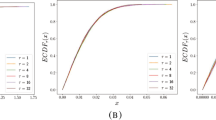Abstract
Fractal investigation of time series is very complex for several reasons. Due to the existence of fully continuous model, on which the majority of conventional methods are based, the quality of Hurst exponent estimate is often influenced by the number of input data and its sampling rate. In this work, we present a novel approach of unbiased Hurst exponent estimate that is suitable especially for short time series. The crucial idea is deriving the discrete fractional Brownian bridge and its statistical properties that can be subsequently used for model parameter estimation. For the verification and demonstration of efficiency of the method, several generators of fractional Gaussian noise are presented and tested.


Similar content being viewed by others
References
Abry, P., Sellan, F.: The wavelet-based synthesis for fractional Brownian motion proposed by F. Sellan and Y. Meyer: remarks and fast implementation. Appl. Comput. Harmon. Anal. 3(4), 377–383 (1996). https://doi.org/10.1006/acha.1996.0030
Borowska, M., Borys, K., Szarmach, J., Oczeretko, E.: Fractal dimension in textures analysis of xenotransplants. Signal Image Video Process. 11(8), 1461–1467 (2017). https://doi.org/10.1007/s11760-017-1108-5
Campanharo, A., Ramos, F.M.: Hurst exponent estimation of self-affine time series using quantile graphs. Physica A Stat. Mech. Appl. 444, 43–48 (2016). https://doi.org/10.1016/j.physa.2015.09.094
Cherouat, S., Soltani, F., Schmitt, F., Daout, F.: Using fractal dimension to target detection in bistatic SAR data. Signal Image Video Process. 9(2), 365–371 (2013). https://doi.org/10.1007/s11760-013-0453-2
Dietrich, C.R., Newsam, G.N.: Fast and exact simulation of stationary gaussian processes through circulant embedding of the covariance matrix. SIAM J. Sci. Comput. 18(4), 1088–1107 (1997). https://doi.org/10.1137/s1064827592240555
Dlask, M., Kukal, J., Tran, Q.V.: Revisited zero-crossing method for hurst exponent estimation in time series. In: Martincik, D. (ed.) Mathematical Methods in Economics Proceedings 2015, vol. 1, pp. 115–120. University of West Bohemia, Plzen, University of West Bohemia, Cheb (2015)
Falconer, K.: Fractal Geometry: Mathematical Foundations and Applications. Wiley, Chichester (2003)
Han, D., Chung, J.: Self-similar traffic end-to-end delay minimization multipath routing algorithm. IEEE Commun. Lett. 18(12), 2121–2124 (2014). https://doi.org/10.1109/lcomm.2014.2362747
Hanmandlu, M., Choudhury, D., Dash, S.: Detection of defects in fabrics using topothesy fractal dimension features. Signal Image Video Process. 9(7), 1521–1530 (2014). https://doi.org/10.1007/s11760-013-0604-5
Hurst, H.E.: Methods of using long-term storage in reservoirs. Proc. Inst. Civ. Eng. 5(5), 519–543 (1956). https://doi.org/10.1680/iicep.1956.11503
Oleg, I., Sheluhin, M.: Self-Similar Processes in Telecommunications. Wiley, Chichester (2007)
Incio, P., Freire, M.: Fast synthesis of persistent fractional brownian motion. ACM Trans. Model. Comput. Simul. 22(2), 1–21 (2012). https://doi.org/10.1145/2133390.2133395
Ionescu, C.M., Sabatier, J., Machado, J.A.T.: Special issue: fractional signals and systems. Signal Image Video Process. 6(3), 341–342 (2012). https://doi.org/10.1007/s11760-012-0313-5
Istas, J., Lang, G.: Quadratic variations and estimation of the local hölder index of a gaussian process. Ann. de l’Institut Henri Poincare (B) Prob. Stat. 33(4), 407–436 (1997). https://doi.org/10.1016/s0246-0203(97)80099-4
Jefferies, B.R.: Spectral Properties of Noncomputing Operators. Lecture Notes in Mathematics. Springer, Berlin (2004)
Julian, M., Alcaraz, R., Rieta, J.J.: Application of hurst exponents to assess atrial reverse remodeling in paroxysmal atrial fibrillation. Physiol. Meas. 36(11), 2231–2246 (2015). https://doi.org/10.1088/0967-3334/36/11/2231
Lowen, S.B.: Generation of fractional brownian motion for simulation of infrared foal-plane array calibration drift. Methodol. Comput. Appl. Prob. 1(4), 445–456 (1999). https://doi.org/10.1023/a:1010027211901
Ludena, C., Lavielle, M.: The whittle estimator for strongly dependent stationary gaussian fields. Scand. J. Stat. 26(3), 433–450 (1999). https://doi.org/10.1111/1467-9469.00158
Luo, J., Xie, Z., Xie, M.: Interpolated DFT algorithms with zero padding for classic windows. Mech. Syst. Signal Process. 70–71, 1011–1025 (2016). https://doi.org/10.1016/j.ymssp.2015.09.045
Makarava, N., Holschneider, M.: Estimation of the hurst exponent from noisy data: a bayesian approach. Eur. Phys. J. B 85(8), 5 (2012). https://doi.org/10.1140/epjb/e2012-30221-1
Mandelbrot, B., Ness, J.V.: Fractional brownian motions, fractional noises and applications. SIAM Rev. 10(4), 422–437 (1968)
Mansuy, R.: Aspects of Brownian Motion. Springer, Altona (2008)
Maxim, V., Sendur, L.: Fractional gaussian noise, functional MRI and alzheimers disease. NeuroImage 25(1), 141–158 (2005). https://doi.org/10.1016/j.neuroimage.2004.10.044
Ming, L.: Fractional Gaussian noise and network traffic modeling. In: A. Cañada, P. Drábek, A. Fonda (eds.) Proceedings of the 8th WSEAS International Conference on Applied Computer and Applied Computational Science, vol. 1, pp. 34–39. School of Information Science Technology East China Normal University, Hangzhou (2009)
Mohindru, P., Khanna, R., Bhatia, S.S.: New tuning model for rectangular windowed FIR filter using fractional fourier transform. Signal Image Video Process. 9(4), 761–767 (2013). https://doi.org/10.1007/s11760-013-0515-5
Seber, G., Wild, C.: Nonlinear Regression. Wiley, Hoboken (2003)
Suman, S., Kumar, A., Singh, G.K.: A new method for higher-order linear phase FIR digital filter using shifted chebyshev polynomials. Signal Image Video Process. 10(6), 1041–1048 (2015). https://doi.org/10.1007/s11760-015-0856-3
Tam, C.M.: Fractional Brownian motions in financial models and their Monte Carlo simulation. In: Recent Advances in Financial Engineering 2012. World Scientific Publishing Co Pvt Ltd (2014). https://doi.org/10.1142/9789814571647_0007
Theiler, J.: Efficient algorithm for estimating the correlation dimension from a set of discrete points. Phys. Rev. A 36(9), 4456–4462 (1987). https://doi.org/10.1103/physreva.36.4456
Tran, Q.V., Jan, K.: Visual recurrent analysis and its application on the czech stock market. Politick Ekonom. 57(3), 305–322 (2009)
Tzouras, C.A., McCoy, E.: Financial time series modeling using the hurst exponent. Physica A Stat. Mech. Appl. 425, 50–68 (2015). https://doi.org/10.1016/j.physa.2015.01.031
Vahid, F.: Digital Design with RTL Design, Verilog and VHDL. Wiley, Hoboken (2011)
Wu, Y., Verdu, S.: Renyi information dimension: fundamental limits of almost lossless analog compression. IEEE Trans. Inform. Theory 56(8), 3721–3748 (2010). https://doi.org/10.1109/tit.2010.2050803
Acknowledgements
The paper was created with the support of the Grant SGS14/208/OHK4/3T/14 as Student Grant Competition at the Czech Technical University in Prague.
Author information
Authors and Affiliations
Corresponding author
Appendices
Appendix A: MATLAB code of fractional Brownian bridge
The following code provides the calculation of the dfBB (Xk) and fBB (Mk) of the given time series x.

Appendix B: MATLAB code of autocorrelation function of dfBB
The following code provides the calculation of the mth autocorrelation coefficient of theoretical dfBB constructed from the bridge of length N and Hurst coefficient H.

Rights and permissions
About this article
Cite this article
Dlask, M., Kukal, J. Hurst exponent estimation from short time series. SIViP 13, 263–269 (2019). https://doi.org/10.1007/s11760-018-1353-2
Received:
Revised:
Accepted:
Published:
Issue Date:
DOI: https://doi.org/10.1007/s11760-018-1353-2




